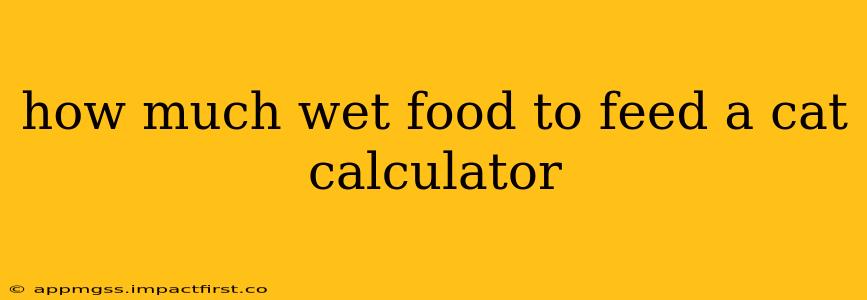Feeding your feline friend the right amount of wet food is crucial for their health and well-being. Too little, and they might be malnourished. Too much, and they could become overweight, leading to various health problems. While there's no single "perfect" wet food calculator that applies to every cat, understanding the factors involved and using guidelines can help you determine the appropriate portion size. This guide will walk you through the process, addressing common questions and concerns.
What Factors Influence a Cat's Wet Food Needs?
Several factors influence how much wet food your cat needs daily. These include:
- Age: Kittens require more calories than adult cats, while senior cats may need less due to slower metabolisms.
- Weight: A heavier cat naturally needs more food than a smaller cat.
- Activity Level: A highly active cat will burn more calories than a less active cat. Indoor cats generally require less food than outdoor cats.
- Breed: Certain breeds have different metabolic rates and may require adjusted food intake.
- Health Conditions: Cats with underlying health issues, such as hyperthyroidism or diabetes, may need a specific dietary plan prescribed by a veterinarian.
- Type of Wet Food: The calorie density of wet food varies significantly between brands and recipes. Always check the feeding guidelines on the food can or pouch.
How to Use a Wet Food Feeding Guide (Instead of a Calculator)
While a precise "calculator" doesn't exist, most reputable wet cat food brands provide feeding guidelines on their packaging. These guidelines are usually based on the cat's weight and are a good starting point. Always refer to the specific instructions on your cat's food.
Here's how to interpret a typical feeding guide:
- Find your cat's weight: Weigh your cat using a pet scale for the most accurate measurement.
- Locate the feeding chart: The can or pouch of wet food will have a chart or table showing recommended daily servings based on weight.
- Adjust for activity level and age: If your cat is very active or a kitten, you may need to slightly increase the amount. If your cat is older or less active, you may need to slightly decrease it.
Important Note: These guidelines are just starting points. Regularly monitor your cat's weight and body condition to ensure you're feeding the appropriate amount.
How Often Should I Feed My Cat Wet Food?
Most adult cats do well with two meals a day, but kittens might need three or more smaller meals. Consult your vet for specific recommendations, especially for kittens, senior cats, or cats with health concerns.
What if My Cat Seems Hungry or Overweight?
- Hungry: If your cat seems hungry despite following the feeding guidelines, consult your veterinarian. They can rule out any underlying medical conditions and help you determine the appropriate food intake.
- Overweight: If your cat is overweight, work with your vet to develop a weight-loss plan. This may involve reducing food intake, increasing exercise, or switching to a lower-calorie food.
How Can I Tell if My Cat is at a Healthy Weight?
You should be able to easily feel your cat's ribs without pressing hard. A healthy cat will have a slight waistline when viewed from above. If you're unsure about your cat's weight, your veterinarian can assess their body condition score.
My Cat is a Picky Eater - What Should I Do?
Some cats are simply picky eaters. If your cat refuses a particular type of wet food, try offering different flavors and brands. Make sure the food is fresh and at the right temperature. Avoid constantly switching foods, as this can upset their digestive system.
Can I Combine Wet and Dry Food?
Yes, many cat owners successfully combine wet and dry food. This can be a good way to ensure your cat gets adequate hydration and nutrients. However, make sure you adjust the overall daily calorie intake to avoid overfeeding. Again, always check the feeding guidelines on the specific products you use.
By following these guidelines and paying close attention to your cat's individual needs, you can ensure they receive the right amount of wet food to maintain a healthy weight and lifestyle. Remember to always consult your veterinarian if you have any concerns about your cat's diet or health.
